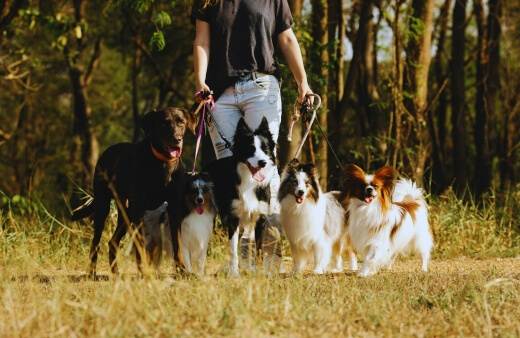Dog walks are a daily necessity for dogs. It gives them much needed exercise, and helps trim their nails through natural wear. But walking your dog is also really beneficial for their human counterparts.
Walking your dog can help improve heart health, build bone strength, ease pain, and lift mood. If done correctly, they can also support rehabilitation after an injury. This guide will discuss how to turn daily dog walks into a structured session that helps you and your dog.

Why Dog Walking Works
Walking makes use of large muscle groups, raises your heart rate, and works your aerobic system. It also puts pressure on your bones and tendons, strengthening them. Walking the dog and experiencing a bit of pulling adds a bit of balance to your walking, which trains your ankles, hips, and core benefiting both you and your dog in the process.
Combined with a steady rhythm and fresh air, walking your dog can drop your stress levels and improve focus. It’s perfect for both dog and human in regaining calm and improving fitness. And your dog will be great at keeping you committed every day.
Step 1: Set your goal
Focusing on a specific goal helps keep you on track. Here are some sample goals you can aim for:
- Heart health: improve stamina and lower resting heart rate.
- Weight control: raise metabolism and burn calories
- Rehabilitation Support: gently restore range of movement
- Mood and stress: relieve stress and improve mood and sharpen focus
Note a baseline today:
- Resting pulse on waking.
- A simple 10-minute out-and-back pace or distance.
- Step count on a normal day.
- Perceived effort on a 1–10 scale at a brisk pace.
Step 2: Build a safe set-up with your dog
Before you begin your walks, make sure you’re prepared with the right equipment:
- Choose a good harness over a collar: Harnesses spread pressure across your dog’s body more evenly and gives you better control, allowing for a more comfortable walk for both of you.
- Get a leash with good grip: Try to find a leash with a fixed length of 1.5–2 m for control.
- Get the right shoes: Find a quality pair of shoes with good heal and midfoot support to protect your ankles and knees, as well as good traction to protect yourself from any unnecessary slips, especially with a hyperactive dog pulling.
- Bring water for you and your dog, some poop bags, and a foldable bowl: These will keep you prepared for you and your dog’s needs during the walk. And just as the right leash and harness keep your walks safe, having the right pet insurance can give you peace of mind in case of accidents or unexpected vet visits.
- Light or reflective gear: If you’re planning to walk at night, bring some extra reflective gear to assure you guys are visible at all times.
Step 3: Learn your training zones
Use the talk test and an effort scale to gauge where you’re at:
- Easy (2–3/10): You can still speak in full sentences.
- Brisk (4–6/10): You can still speak in short phrases, quicker pace and arms swinging.
- Push (7/10): You can only speak in single words between breaths.
Most of your walk should be in the brisk range, but add short push bouts to improve fitness once you get more used to doing this daily.
Step 4: Warm-up and technique
A walk may feel like a simple thing, but it can make a huge difference when done regularly. Start with 3–5 minutes at an easy pace. Let your dog sniff, circle, and find his rhythm. For you, keep your shoulders back, stand upright, and move your arms along while you walk. Try not to slouch. Your dog mirrors your energy so if you’re calm and in control, your dog will be relaxed during the walk as well. For older adults or those managing conditions like arthritis, this can be a gentle and safe way to stay active.

Step 5: Dose volume and intensity
Think in minutes per week, not just “daily walks.” Current guidelines suggest 150 minutes of moderate activity. With a dog, you can exceed this with ease. Break it into:
- 5 sessions x 30 minutes at brisk pace
- or 7 sessions x 20–25 minutes
Track your effort daily. You should breathe harder than when you’re not moving but still be able to hold short talk. If you’re a senior or have recent injuries, aim for shorter sessions. Frequency trumps long sessions when there is stiffness.
If you’re trying to control your weight, extend your sessions to 40 to 50 minutes and try to keep your pace brisk. Dogs with strong stamina such as Shepherds and Retrievers will particularly enjoy this, but lower energy breeds such as French Bulldogs and Shih Tzus will need more breaks.
Step 6: Mix the terrain
Opting for varied ground will challenge your balance and stability.
- Grass or dirt tracks: softer on joints.
- Hills: adds resistance for calves, glutes, and dog’s hind limbs.
- Sand: great strength builder due to difficulty level.
- Pavement: easy for pace tracking but has a higher impact on joints.
Change up the terrain. Alternate short hill walks with brisk loops around a park. These will work a bit like interval training, which will keep your dog alert and your workout challenging.
If walking feels tough on your joints, consider complementing your routine with hydrotherapy.
Step 7: Use the dog as motivator
Research shows pet owners stick to plans longer. The reason is clear: your dog will ask for the walk. Skipping a session feels like letting your partner down. This natural accountability builds routine. Dogs also show visible joy, which lifts mood and lowers perceived effort. Owners report lower stress and better sleep after regular evening walks.
Step 8: Therapy benefits
Dog walking is more than just fitness, it can help with various groups and here’s how:
- Older adults: regular leash walks reduce fall risk by strengthening legs and improving coordination.
- Cardiac rehab patients: brisk walking helps retrain heart response, with a dog providing gentle pace control.
- Arthritis or joint pain: short, frequent walks lubricate joints, ease stiffness, and reduce weight load.
- Mental health support: walking with a dog lowers cortisol, eases anxiety, and raises serotonin. The presence of a pet makes the walk feel less like “therapy” and more like shared joy.
Studies show pet owners walk on average 20–30 minutes more per day than non-owners. This extra time accumulates into real health gains: lower BMI, improved blood pressure, and reduced risk of type 2 diabetes.
Step 9: Progress long-term
After the first month, keep momentum by:
- Setting step goals (8,000–10,000 per day for most adults).
- Varying routes to keep mind and dog engaged.
- Adding social walks with friends or group classes.
- Tracking heart rate zones with a simple monitor.
Remember: Consistency trumps intensity. Five brisk 25-minute walks per week deliver better long-term results than one intense 90-minute walk followed by days off.

Practical Tips for Safe, Lifelong Walking
- Match pace to breed and age: Greyhounds enjoy brisk, shorter bursts; retrievers excel on long, steady routes; seniors or brachycephalic breeds need shorter walks with rest breaks.
- Hydrate both walker and dog: Carry water for longer sessions, especially in warm weather.
- Check paws and shoes: Inspect your dog’s pads after rough ground; replace your own shoes every 500–800 km to avoid joint stress.
- Mind the weather: Avoid extreme heat or icy paths. Early morning or evening is often best.
- Build gradually: Increase time or intensity by no more than 10% per week.
- Stay engaged: Use cues, short training drills, or fetch breaks during walks to keep the mind as active as the body.
Dog Walking Improves Health for Both You and Your Dog
Walking your dog is one of the easiest ways to get steps in while sharing a wonderful bonding session with your beloved pet. Seeing dog walking as more than a routine or chore, but as a sustainable road to health, one that heals joints, improves mood, and gets you moving, can hopefully motivate you to push yourself more and more everyday while having a wonderful time with your dog.
Want help building your plan? Meet our team or book an appointment to get started.
Learn more about SSEP and how we can support your rehab or performance goals.
